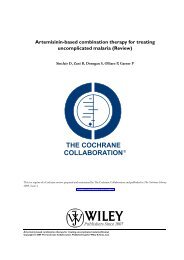Antiamoebic drugs for treating amoebic colitis - The Cochrane Library
Antiamoebic drugs for treating amoebic colitis - The Cochrane Library
Antiamoebic drugs for treating amoebic colitis - The Cochrane Library
You also want an ePaper? Increase the reach of your titles
YUMPU automatically turns print PDFs into web optimized ePapers that Google loves.
trial authors <strong>for</strong> clarification. We noted the reasons <strong>for</strong> excluding<br />
studies.<br />
Data extraction and management<br />
Two authors (MLM Gonzales and EG Martinez) independently<br />
extracted data from the trials using pre-tested data extraction<br />
<strong>for</strong>ms. We collected details regarding the inclusion and exclusion<br />
criteria <strong>for</strong> the participants, treatment intervention given, total<br />
number randomized, number of participants in each group <strong>for</strong> all<br />
outcomes, drop outs and withdrawals, and numbers experiencing<br />
each outcome. For dichotomous data, we extracted the number of<br />
participants who experienced the event of interest and the number<br />
of participants randomized and analysed in each treatment group.<br />
We resolved any disagreements by referring to the trial report and<br />
through discussion. Where data were insufficient or missing, we<br />
made attempts to contact the trial authors. MLM Gonzales entered<br />
data <strong>for</strong> analysis using double data entry.<br />
Assessment of risk of bias in included studies<br />
Two authors (MLM Gonzales and LF Dans) independently assessed<br />
the risk of bias in each trial using a prepared <strong>for</strong>m. We assessed<br />
the generation of allocation sequence and allocation concealment<br />
as adequate, inadequate, or unclear according to Jüni<br />
2001. We noted who was blinded, such as the trial participants,<br />
care providers, or outcome assessors, and assessed the inclusion<br />
of randomized participants in the analysis as adequate if 90% or<br />
greater, and inadequate if not.<br />
Assessment of reporting biases<br />
We determined publication bias by looking <strong>for</strong> asymmetry in a<br />
funnel plot. <strong>The</strong> presence of asymmetry in the funnel plot suggests<br />
possible publication bias, although it may also indicate heterogeneity<br />
or poor methodological quality of the trials.<br />
Data synthesis<br />
We analysed data collected using Review Manager 5. For dichotomous<br />
outcomes, we calculated risk ratios (RR) with 95% confidence<br />
intervals (CI).<br />
Stratification of results<br />
<strong>The</strong> main comparisons were between any single anti<strong>amoebic</strong> drug<br />
and metronidazole (current standard therapy), any anti<strong>amoebic</strong><br />
drug and placebo, combination regimens and monotherapy, and<br />
any single-dose regimen and longer regimens. We included but<br />
did not pool data from other trials that compared any anti<strong>amoebic</strong><br />
drug with another anti<strong>amoebic</strong> drug and did not address any particular<br />
pharmacological or clinical question relevant to this review.<br />
For trials reporting results at multiple or varying time points, we<br />
per<strong>for</strong>med separate analyses <strong>for</strong> outcomes measured from the end<br />
of treatment to 14 days and from 15 to 60 days after the end of<br />
treatment. In trials comparing <strong>drugs</strong> with different treatment durations,<br />
we measured the time point in relation to the last day of<br />
the longest treatment period. We did not consider outcomes that<br />
were measured during treatment or be<strong>for</strong>e completion of treatment.<br />
Likewise, we did not include outcomes measured beyond<br />
two months because this could be a reinfection rather than true<br />
failure or relapse.<br />
Heterogeneity<br />
We calculated summary RR from meta-analysis using both a fixedeffect<br />
model (Mantel-Haenszel method), which assumes trial homogeneity,<br />
and a random-effects model (DerSimonian and Laird<br />
method), which accounts <strong>for</strong> trial heterogeneity.<br />
We reported results using the random-effects model when there<br />
were differences between trials that may potentially influence the<br />
size of the treatment effect or when significant statistical heterogeneity<br />
was detected. We determined the presence of statistical<br />
heterogeneity among the same interventions by inspecting the <strong>for</strong>est<br />
plots <strong>for</strong> overlapping confidence intervals and by applying the<br />
Chi 2 test <strong>for</strong> heterogeneity (P value < 0.10 considered statistically<br />
significant) and the I 2 statistic to quantify inconsistency across trials<br />
(I 2 value of greater than 50% used to denote substantial heterogeneity).<br />
If heterogeneity was detected, but it was still considered<br />
clinically meaningful to combine trial data, we explored potential<br />
sources of heterogeneity using subgroup analysis. Only subtotals<br />
<strong>for</strong> each subgroup were presented if the pooled results showed significant<br />
heterogeneity. We determined clinical categories (<strong>amoebic</strong><br />
dysentery, nondysenteric <strong>amoebic</strong> <strong>colitis</strong>, or unspecified <strong>amoebic</strong><br />
<strong>colitis</strong>) and participant age (adults were those aged 15 years or<br />
more, and children were those aged less than 15 years) to be important<br />
subgroups even be<strong>for</strong>e data collection although we failed<br />
to specify this in the protocol. Subgroup analysis could not be<br />
undertaken as planned based on diagnostic tests because only one<br />
trial used a stool E. histolytica ELISA test. <strong>The</strong> post hoc sources of<br />
heterogeneity considered were types of intestinal infection (E. histolytica<br />
infection alone or mixed intestinal infection), criteria <strong>for</strong><br />
determining outcome (based on WHO 1969 criteria or another<br />
criteria), and regimens used.<br />
Sensitivity analysis<br />
<strong>Anti<strong>amoebic</strong></strong> <strong>drugs</strong> <strong>for</strong> <strong>treating</strong> <strong>amoebic</strong> <strong>colitis</strong> (Review)<br />
Copyright © 2009 <strong>The</strong> <strong>Cochrane</strong> Collaboration. Published by John Wiley & Sons, Ltd.<br />
We per<strong>for</strong>med sensitivity analyses to assess the robustness of the<br />
overall estimates by calculating the results using all trials and then<br />
excluding trials of a lower methodological quality (ie trials with<br />
inadequate generation of allocation sequence, allocation concealment,<br />
or blinding, or trials where less than 90% of randomized<br />
participants were analysed), and excluding trials that were sponsored<br />
by pharmaceutical companies. Although pharmaceuticalsponsored<br />
trials may publish only where demonstrating positive<br />
treatment effects, it may also be possible that pharmaceutical-<br />
7








